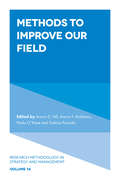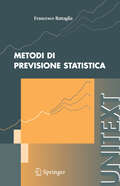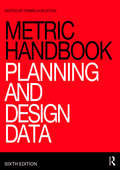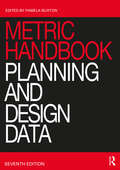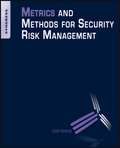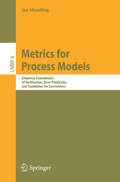- Table View
- List View
Methods of Moments and Semiparametric Econometrics for Limited Dependent Variable Models
by Myoung-jae LeeIn this book the author surveys new techniques in econometrics which may be used to analyse semiparametric models. As well as covering topics such as instrumental variable estimation, nonparametric density and regression function estimation and semiparametric limited dependent variable models, the book provides details of how these methods may be implemented using software.
Methods of Money Laundering: Circumventing Anti-Money Laundering Mechanisms
by Fabian TeichmannHow exactly is money laundered? The answer to this question is not well understood – and for this very reason, costly prevention measures remain ineffective. This much-needed book provides the first in-depth explanation of the methods used by intelligent criminals to amass wealth from large-scale trafficking in drugs, arms, and human beings, as well as from less odious crimes. The author shows clearly not only why existing approaches to combat money laundering are bound to fail but also how money launderers easily circumvent such measures. Based on qualitative interviews with both alleged criminals and prevention experts, detailed illustrations of concrete steps taken by intelligent and specialized perpetrators of money laundering allow practitioners to anticipate and effectively combat this type of crime. The author fully documents such aspects of money launderers’ behaviour as the following: resources required; dealing with detection risks; and international mobility. A central chapter covers in depth the various markets, institutions, and facilities that are particularly favourable to money laundering, and original insights accompany the presented findings with relevant quotations from the interviewees. The author offers tailored recommendations for different professional groups, including bankers, prosecutors, defence lawyers, and judges. In its critical questioning of the logic behind anti-money laundering regulations and their costly implementation, the book demonstrates that either the existing measures of prevention are drastically tightened and extended to almost all branches of the economy or the financial sector is relieved of the burden it bears and alternative ways of fighting this type of crime are sought instead. It will prove enormously valuable to understanding and investigating white-collar and financial crime, and be welcomed by practitioners and professionals in financial markets, banking, criminal lawyers, and compliance experts, as well as academia.
Methods to Analyse Agricultural Commodity Price Volatility
by Isabelle Piot-Lepetit and Robert M'BarekThis book examines the issue of price volatility in agricultural commodities markets and how this phenomenon has evolved in recent years. The factors underlying the price spike of 2007-08 appear to be global and macroeconomic in nature, including the rapid growth in demand by developing countries, the international financial crisis, and exchange rate movements. Some of these factors are new, appearing as influences on price volatility only in the last decade. Although volatility has always been a feature of agricultural commodity markets, the evidence suggests that volatility has increased in certain commodity markets. A growing problem is that agricultural price shocks and volatility disrupt agricultural markets, economic incentives and incomes. With increased globalization and integration of financial and energy markets with agricultural commodity markets, the relationships between markets are expanding and becoming more complex. When a crisis such as a regional drought, food safety scare or a financial crisis hits a particular market, policy-makers often do not know the extent to which it will impact on other markets and affect producer, consumer and trader decisions. Including contributions from experts at the World Bank, the Food and Agriculture Organization of the United Nations, the USDA, and the European Commission, the research developed throughout the chapters of this book is based on current methodologies that can be used to analyze price volatility and provide directions for understanding this volatility and the development of new agricultural policies. The book highlights the challenges facing policy makers in dealing with the changing nature of agricultural commodities markets, and offers recommendations for anticipating price movements and managing their consequences. It will be a practical guide for both present and future policy-makers in deciding on potential price-stabilizing interventions, and will also serve as a useful resource for researchers and students in agricultural economics.
Methods to Improve Our Field (Research Methodology in Strategy and Management #14)
by Aaron D. Hill, Aaron F. Mckenny, Paula O'Kane, Sotirios ParoutisResearch Methodology in Strategy and Management advances understanding of the methods used to study organizations – including managers, strategies, and how firms succeed. Offering innovative ideas that explore how strategy and management methodology can be developed, the chapter authors in Volume 14, Methods to Improve Our Field, consider approaches that range from the re-imagining of secondary data in the digital age and Interpretive Phenomenological Analysis (IPA) to Machine Learning and Artificial Intelligence. Methods to Improve Our Field is a necessity for both academics and researchers interested in the progression and cutting-edge studies of management, strategy, international business, entrepreneurship, and organization theory.
Methods to Improve Our Field (Research Methodology in Strategy and Management #14)
by Aaron F. McKenny Paula O'Kane Sotirios Paroutis Aaron D. HillResearch Methodology in Strategy and Management advances understanding of the methods used to study organizations – including managers, strategies, and how firms succeed. Offering innovative ideas that explore how strategy and management methodology can be developed, the chapter authors in Volume 14, Methods to Improve Our Field, consider approaches that range from the re-imagining of secondary data in the digital age and Interpretive Phenomenological Analysis (IPA) to Machine Learning and Artificial Intelligence. Methods to Improve Our Field is a necessity for both academics and researchers interested in the progression and cutting-edge studies of management, strategy, international business, entrepreneurship, and organization theory.
Metodi di previsione statistica (UNITEXT)
by Francesco BattagliaIl testo presenta gli sviluppi matematici e statistici relativi alo studio dei fenomeni dipendenti dal tempo, con l'obiettivo di mettere in grado il lettore di comprendere ed utilizzare i metodi di previsione statistica per le serie temporali, le catene di Markov, i processi di punti. L'attenzione è posta sia sugli aspetti strutturali probabilistici, illustrandoli nel dominio temporale e in quello frequenziale, sia su quelli statistici relativi all'inferenza .Il libro nasce come testo per corsi di previsione statistica sia di laurea triennale sia di specialistica, con due diversi percorsi, ma risulta utile come testo di riferimento e di guida all'approfondimento anche per corsi avanzati e di dottorato, e per i ricercatori impegnati, in ogni campo, nell'attività di previsione .
Metric Handbook: Planning and Design Data
by Pamela BuxtonSignificantly updated in reference to the latest construction standards and new building types Sustainable design integrated into chapters throughout Over half of the entire book has now been updated since 2015 Over 100,000 copies sold to successive generations of architects and designers This book belongs in every design office. The Metric Handbook is the major handbook of planning and design data for architects and architecture students. Covering basic design data for all the major building types it is the ideal starting point for any project. For each building type, the book gives the basic design requirements and all the principal dimensional data, and succinct guidance on how to use the information and what regulations the designer needs to be aware of. As well as buildings, the Metric Handbook deals with broader aspects of design such as materials, acoustics and lighting, and general design data on human dimensions and space requirements. The Metric Handbook is the unique reference for solving everyday planning problems.
Metric Handbook: Planning and Design Data
by Pamela BuxtonSignificantly updated in reference to the latest construction standards and new building types Sustainable design integrated into chapters throughout Over half of the entire book has now been updated since 2015 Over 100,000 copies sold to successive generations of architects and designers This book belongs in every design office. The Metric Handbook is the major handbook of planning and design data for architects and architecture students. Covering basic design data for all the major building types it is the ideal starting point for any project. For each building type, the book gives the basic design requirements and all the principal dimensional data, and succinct guidance on how to use the information and what regulations the designer needs to be aware of. As well as buildings, the Metric Handbook deals with broader aspects of design such as materials, acoustics and lighting, and general design data on human dimensions and space requirements. The Metric Handbook is the unique reference for solving everyday planning problems.
Metric Handbook: Planning and Design Data
by Pamela BuxtonConsistently updated since 2015 by expert authors in the field Significantly revised in reference to changing building types and construction standards New chapters added on data centres and logistics facilities Sustainable design integrated into chapters throughout Over 100,000 copies sold to successive generations of architects and designers This book belongs in every design office. The Metric Handbook is the major handbook of planning and design data for architects and architecture students. Covering basic design data for all the major building types, it is the ideal starting point for any project. For each building type, the book gives the basic design requirements and all the principal dimensional data, and succinct guidance on how to use the information and what regulations the designer needs to be aware of. As well as buildings, the Metric Handbook deals with broader aspects of design such as materials, acoustics, and lighting, and general design data on human dimensions and space requirements. The Metric Handbook is the unique reference for solving everyday planning problems.
Metric Handbook: Planning and Design Data
by Pamela BuxtonConsistently updated since 2015 by expert authors in the field Significantly revised in reference to changing building types and construction standards New chapters added on data centres and logistics facilities Sustainable design integrated into chapters throughout Over 100,000 copies sold to successive generations of architects and designers This book belongs in every design office. The Metric Handbook is the major handbook of planning and design data for architects and architecture students. Covering basic design data for all the major building types, it is the ideal starting point for any project. For each building type, the book gives the basic design requirements and all the principal dimensional data, and succinct guidance on how to use the information and what regulations the designer needs to be aware of. As well as buildings, the Metric Handbook deals with broader aspects of design such as materials, acoustics, and lighting, and general design data on human dimensions and space requirements. The Metric Handbook is the unique reference for solving everyday planning problems.
Metrics: How to Improve Key Business Results
by Martin KlubeckMetrics are a hot topic. Executive leadership, boards of directors, management, and customers are all asking for data-based decisions. As a result, many managers, professionals, and change agents are asked to develop metrics, but have no clear idea of how to produce meaningful ones. Wouldn’t it be great to have a simple explanation of how to collect, analyze, report, and use measurements to improve your organization? Metrics: How to Improve Key Business Results provides that explanation and the tools you'll need to make your organization more effective. Not only does the book explain the “why” of metrics, but it walks you through a step-by-step process for creating a report card that provides a clear picture of organizational health and how well you satisfy customer needs. Metrics will help you to measure the right things, the right way—the first time. No wasted effort, no chasing data. The report card provides a simple tool for viewing the health of your organization, from the outside in. You will learn how to measure the key components of the report card and thereby improve real measures of business success, like repeat customers, customer loyalty, and word-of-mouth advertising. This book: Provides a step-by-step guide for building an organizational effectiveness report card Takes you from identifying key services and products and using metrics, to determining business strategy Provides examples of how to identify, collect, analyze, and report metrics that will be immediately useful for improving all aspects of the enterprise, including IT
Metrics 2.0: Creating Scorecards for High-Performance Work Teams and Organizations
by Ruth A. HuweThis one-stop handbook gives managers who have been charged with creating metric scorecards techniques that will make them truly effective.Written for managers who want/need to create and use scorecards, Metrics 2.0: Creating Scorecards for High-Performance Work Teams and Organizations provides a unique perspective on this vital management tool. Focusing on performance improvement, it describes the intellectual foundation behind scorecards and demonstrates how metrics can be used to enhance feedback, motivation, and employee engagement.The book offers a background primer on statistics and research methods, outlining the basics of metrics such as attributes, scope of measures, and levels of analysis to help managers understand what should go into the scorecard and why. Key techniques for using scorecards are showcased and step-by-step guidance on creating metric scorecards for teams, departments, and entire organizations is provided, including specialized situations such as customer service measurement or monitoring off-site performance. Finally, managers are taught how to analyze results intelligently and translate metrics into effective operational practices. Extensive running examples address both service and manufacturing metrics and each chapter ends with a set of learning objectives.
Metrics and Methods for Security Risk Management
by Carl YoungSecurity problems have evolved in the corporate world because of technological changes, such as using the Internet as a means of communication. With this, the creation, transmission, and storage of information may represent security problem. Metrics and Methods for Security Risk Management is of interest, especially since the 9/11 terror attacks, because it addresses the ways to manage risk security in the corporate world. The book aims to provide information about the fundamentals of security risks and the corresponding components, an analytical approach to risk assessments and mitigation, and quantitative methods to assess the risk components. In addition, it also discusses the physical models, principles, and quantitative methods needed to assess the risk components. The by-products of the methodology used include security standards, audits, risk metrics, and program frameworks. Security professionals, as well as scientists and engineers who are working on technical issues related to security problems will find this book relevant and useful. Offers an integrated approach to assessing security riskAddresses homeland security as well as IT and physical security issuesDescribes vital safeguards for ensuring true business continuity
Metrics for Process Models: Empirical Foundations of Verification, Error Prediction, and Guidelines for Correctness (Lecture Notes in Business Information Processing #6)
by Jan MendlingBusiness process modeling plays an important role in the management of business processes. As valuable design artifacts, business process models are subject to quality considerations. The absence of formal errors such as deadlocks is of paramount importance for the subsequent implementation of the process. In his book Jan Mendling develops a framework for the detection of formal errors in business process models and the prediction of error probability based on quality attributes of these models (metrics). He presents a precise description of Event-driven Process Chains (EPCs), their control-flow semantics and a suitable correctness criterion called EPC soundness.
Metrics for Sustainable Business: Measures and Standards for the Assessment of Organizations
by Scott R. HerriottMetrics for Sustainable Business is the first book to give students a comprehensive understanding of sustainability in organizations from an accounting perspective. The book walks student through the steps for doing a sustainability assessment, and aims to develop them into financial analysts who understand sustainability reports, and are able to create or audit them. While most books focus on environmental issues, Herriott trains his gaze on the corporate and institutional perspective, covering measurement systems, how to evaluate and improve a standard, and conducting a life cycle assessment. Walking students through the programs of disclosure, the varying standards for corporate ratings, and organizational certification, allows them to grasp the tools for conducting a sustainability assessment and auditing reports. Chapters on accounting for greenhouse gas emissions, water use, and waste introduce students to the technical details in sustainability accounting, while a chapter on the philosophies of sustainability offers an answer to the question, "Why are they asking us to report that?" Richly demonstrated with practical examples and informative visuals, this book will serve students of sustainability, accounting, and integrated reporting.
Metrics for Sustainable Business: Measures and Standards for the Assessment of Organizations
by Scott R. HerriottMetrics for Sustainable Business is the first book to give students a comprehensive understanding of sustainability in organizations from an accounting perspective. The book walks student through the steps for doing a sustainability assessment, and aims to develop them into financial analysts who understand sustainability reports, and are able to create or audit them. While most books focus on environmental issues, Herriott trains his gaze on the corporate and institutional perspective, covering measurement systems, how to evaluate and improve a standard, and conducting a life cycle assessment. Walking students through the programs of disclosure, the varying standards for corporate ratings, and organizational certification, allows them to grasp the tools for conducting a sustainability assessment and auditing reports. Chapters on accounting for greenhouse gas emissions, water use, and waste introduce students to the technical details in sustainability accounting, while a chapter on the philosophies of sustainability offers an answer to the question, "Why are they asking us to report that?" Richly demonstrated with practical examples and informative visuals, this book will serve students of sustainability, accounting, and integrated reporting.
The Metrics of Happiness: The Art and Science of Measuring Personal Happiness and Societal Wellbeing (Social Indicators Research Series #86)
by R. Allan FreezeThis book provides a comprehensive treatment of how happiness and wellbeing are measured. It presents an accessible summary of the philosophy, methodology, and applicability of the various measurement techniques that have been generated by the leaders of the happiness movement. It traces the history of development of the core ideas, and clarifies the unexpectedly wide range of techniques that are used. The book provides an unbiased assessment of the strengths and weaknesses of each approach and differentiates the contributions that have been made by psychologists, economists, environmentalists, and health scientists. It examines applications at a personal scale, in the workplace, at a societal scale, and on the world stage. It does so in an easy-to-read anecdotal writing style that will appeal to a wide range of academic and lay readers who enjoy popularized non-fiction that address matters of social concern.
The Metrics of Science and Technology (Non-ser.)
by Eliezer GeislerDr. Geisler's far-reaching, unique book provides an encyclopedic compilation of the key metrics to measure and evaluate the impact of science and technology on academia, industry, and government. Focusing on such items as economic measures, patents, peer review, and other criteria, and supported by an extensive review of the literature, Dr. Geisler gives a thorough analysis of the strengths and weaknesses inherent in metric design, and in the use of the specific metrics he cites. His book has already received prepublication attention, and will prove especially valuable for academics in technology management, engineering, and science policy; industrial R&D executives and policymakers; government science and technology policymakers; and scientists and managers in government research and technology institutions.Geisler maintains that the application of metrics to evaluate science and technology at all levels illustrates the variety of tools we currently possess. Each metric has its own unique strengths and weaknesses, but overall, metrics offer the best possible way to evaluate science and technology. He then finds that in general, science and technology have a positive effect on the human experience. Truly state of the art in the study of the metrics of science and technology, their outcomes and contributions to society and the economy, the book provides unique analyses of the academic world and its most useful metrics: the industrial science/technology research and development complex, and the government network of laboratories. For each, Geisler gives a comprehensive analysis of the main metrics and their best applications. His book is thus also usable in certain advanced undergraduate and graduate courses and seminars that treat technology and engineering management, project management in technology industries, and the evaluation of social and economic programs.
Metrics of Subjective Well-Being: Limits and Improvements (Happiness Studies Book Series)
by Gaël Brulé Filomena MagginoThis volume analyses the quantification of the effect of factors measuring subjective well-being, and in particular on the metrics applied. With happiness studies flourishing over the last decades, both in number of publications as well as in their exposure, researchers working in this field are aware of potential weaknesses and pitfalls of these metrics. Contributors to this volume reflect on different factors influencing quantification, such as scale size, wording, language, biases, and cultural comparability in order to raise awareness on the tools and on their conditions of use.
Metro Rail Projects in India: A Study in Project Planning
by M. RamachandranTaking stock of the urban transport scenario in Indian cities, this is the first full-length study of the metro rail system in India. In recent times the metro rail has come up as a favoured alternative of mass transport in urban spaces faced with growing population, heightened vehicular traffic, and increased pollution. Using data, analysis, and first-hand information, this book tells the story of metro rail as proposed and undertaken across Indiafrom Kolkata in the east and Mumbai in the west to Delhi and Jaipur in the north and Chennai, Bangalore, Hyderabad, and Kochi in the south. Focusing on the complexities of project planning and contrasting the Indian experience with those of its global counterparts, this volume distils important lessons for future infrastructure projects. While the metro rail system has considerably improved inter-city connectivity, the metro story in India is an ongoing one. With a Foreword by E. Sreedharan setting the stage, this volume will appeal to anybody keen to know more about urban transport in India, as well as policymakers, management professionals, and students and researchers of economics and business studies.
Metropolitan Economic Development: The Political Economy of Urbanisation in Mexico (Regions and Cities)
by Alejandra Trejo NietoMetropolitan areas are home to a significant proportion of the world’s population and its economic output. Taking Mexico as a case study and weaving in comparisons from Latin America and developed countries, this book explores current trends and policy issues around urbanisation, metropolisation, economic development and city-region governance. Despite their fundamental economic relevance, the analysis and monitoring of metropolitan economies in Mexico and other countries in the Global South under a comparative perspective are relatively scarce. This volume contains empirical analysis based on comparative perspectives with relation to international experiences. It will be of interest to advanced students, researchers and policymakers in urban policy, urban economics, regional studies, economic geography and Latin American studies.
Metropolitan Economic Development: The Political Economy of Urbanisation in Mexico (Regions and Cities)
by Alejandra Trejo NietoMetropolitan areas are home to a significant proportion of the world’s population and its economic output. Taking Mexico as a case study and weaving in comparisons from Latin America and developed countries, this book explores current trends and policy issues around urbanisation, metropolisation, economic development and city-region governance. Despite their fundamental economic relevance, the analysis and monitoring of metropolitan economies in Mexico and other countries in the Global South under a comparative perspective are relatively scarce. This volume contains empirical analysis based on comparative perspectives with relation to international experiences. It will be of interest to advanced students, researchers and policymakers in urban policy, urban economics, regional studies, economic geography and Latin American studies.
Metropolitan Governance in Latin America (Regions and Cities)
by Alejandra Trejo NietoThis book represents a powerful analysis of the challenges of metropolitan governance in all its messiness and complexity. It examines Latin American metropolitan governance by focusing on the issue of public service provision and comparatively examining five of the largest and most complex urban agglomerations in the region: Buenos Aires, Bogota, Lima, Mexico City and Santiago. The volume identifies and discusses the most pressing challenges associated with metropolitan coordination and the coverage, quality and financial sustainability of service delivery. It also reveals a number of spatial inequalities associated with inadequate provision, which may perpetuate poverty and other inequalities. Metropolitan Governance in Latin America will be valuable reading for advanced students, researchers and policymakers tackling themes of urban planning, spatial inequality, public service provision and Latin American urban development.
Metropolitan Governance in Latin America (Regions and Cities)
by Alejandra Trejo Nieto Jose L. Niño AmézquitaThis book represents a powerful analysis of the challenges of metropolitan governance in all its messiness and complexity. It examines Latin American metropolitan governance by focusing on the issue of public service provision and comparatively examining five of the largest and most complex urban agglomerations in the region: Buenos Aires, Bogota, Lima, Mexico City and Santiago. The volume identifies and discusses the most pressing challenges associated with metropolitan coordination and the coverage, quality and financial sustainability of service delivery. It also reveals a number of spatial inequalities associated with inadequate provision, which may perpetuate poverty and other inequalities. Metropolitan Governance in Latin America will be valuable reading for advanced students, researchers and policymakers tackling themes of urban planning, spatial inequality, public service provision and Latin American urban development.
Metropolitan Income Growth and Convergence
by Roberto J. CavazosThis title was first published in 2001. What determines urban growth? Much has been written on particular causes and incidents which can explain the rise of one metropolis and the fall of another, but these do not illustrate general tendencies. This volume asks whether theories used to explain economic growth of nations or regions can be employed to find characteristics which encourage the growth of cities. Cavazos tests two principal theoretical approaches in this way. The first, the endogenous growth theory, predicts that incomes will diverge and sees technological innovations as the engine of economic growth. The second, the neoclassical growth theory, predicts conditional convergence and rates capital accumulation as the key to economic growth. He uses the two models to study US metropolitan income growth between 1970 and 1990 and compares their performance to determine which provides more insightful explanations of metropolitan growth.



